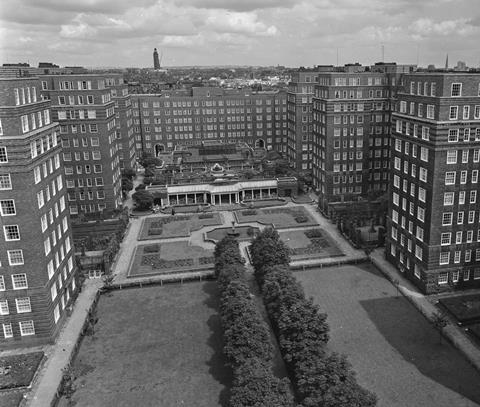Planning inspector to probe redevelopment of 1930s London landmark after councillors overruled officersŌĆÖ advice to approve
Westminster councilŌĆÖs refusal of Eric Parry ArchitectsŌĆÖ plans to add 230 new homes to PimlicoŌĆÖs Dolphin Square is headed to appeal.
Planning officers had supported ParryŌĆÖs proposals for the 1930s quadrangle development ŌĆō long a favourite of MPs, peers and society figures ŌĆō which would have seen the demolition of its northern-most block for replacement with a new 10-storey building.
But Westminster councillors rejected the scheme at a meeting last July, taking particular exception to the proposed increase in the number of serviced apartments at the development, which would have risen from 143 to 160 as part of the proposals.
Now owner Dolphin Square Estate ŌĆō which is controlled by US real-estate firm Westbrook Partners ŌĆō has formally launched a challenge to WestminsterŌĆÖs decision and is seeking a planning inspector-led inquiry into the schemeŌĆÖs acceptability.
As well as demolishing Rodney House and replacing it with a taller block, ParryŌĆÖs scheme involved adding an extra storey to the remaining blocks, creating 16 new townhouses, and reconfiguring existing flats to boost the number of overall units from 1,225 to 1,455 homes.
In its statement of case, Dolphin Square Estate says it will demonstrate that ParryŌĆÖs proposals, along with the public realm work by Todd Longstaffe-Gowan, represent ŌĆ£exemplary standards of sustainable and inclusive urban design and architectureŌĆØ.
The document says the site owner also plans to show that the proposed mix of units is appropriate and meets local demand for smaller, ŌĆ£financially accessibleŌĆØ rental property.
Dolphin Square was designed by Gordon Jeeves and completed in 1938. Despite being acknowledged as a groundbreaking building and forming the centrepiece of the Dolphin Square Conservation Area, it has been rejected for listing on three occasions and currently has immunity from listing.
WestminsterŌĆÖs formal reasons for rejecting the Parry plans were given as harm to the appearance of the building and the character and appearance of the local conservation area; concerns over its mix of housing; and concerns over the intensification of short-term let residential property.




























No comments yet